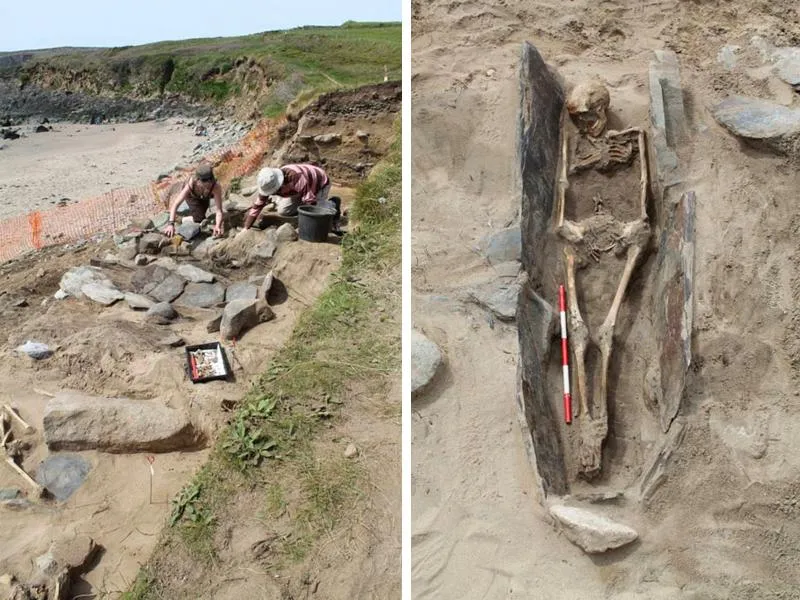Sand Dunes in Wales Preserved This Medieval Cemetery for Centuries
Erosion threatens to destroy the historic burial ground at Whitesands Beach in Pembrokeshire
:focal(353x283:354x284)/https://tf-cmsv2-smithsonianmag-media.s3.amazonaws.com/filer/dc/63/dc636c8a-c389-4cc8-b728-b6f2a8785847/dig_sites.jpg)
Archaeologists surveying Whitesands Beach in Pembrokeshire, Wales, have exhumed almost 200 skeletons dated to the medieval era.
As BBC News reports, the western Welsh beach’s sandy shores ensured the remains’ preservation. Upon the dig’s conclusion, the bodies will be stored at the National Museum of Wales.
“It’s really important because the preservation of the bones, as they are in sand, is absolutely incredible,” archaeologist Jenna Smith tells BBC News. “… It’s really important that we do so because it gives that snapshot in time which we don’t normally get in Wales. The bone doesn’t normally exist.”
The burial site was once home to a medieval trading post with Ireland. According to a statement, archaeologists from the University of Sheffield and the Dyfed Archaeological Trust—a nonprofit organization that seeks to protect and record archaeological finds in Wales—recovered the remains during a six-week dig at the St. Patrick’s Chapel site. The team hopes to finish excavating the area before coastal erosion washes potential finds away.
Researchers used radiocarbon analysis to date the Whitesands cemetery’s use to the 6th through 11th centuries. The graves contained a mix of adults and children of all ages.
Per the statement, the burials were positioned from east to west, with the heads all facing west. In accordance with medieval Christian funerary customs, the deceased were not interred with any personal belongings.
Highlights of the dig included cists, or tombs covered with stone slabs. Though these types of burials were common throughout western Britain in the early medieval era, researchers were surprised to discover quartz pebbles placed atop several of the Whitesands children’s graves, writes John Cooper for Wales Online.

Archaeologists have been investigating the sand dunes since the 1920s. Over the past century or so, erosion and weathering have exposed burials dating as far back as the sixth century. The most recent dig builds on excavations conducted between 2014 and 2016, in the aftermath of severe storms that threatened to destroy the heritage site.
As scholar Duncan Sayer wrote for History Compass in 2013, Christian burials in early medieval Britain were quite varied and often bore markers of the deceased’s socioeconomic status. Churchyard cemeteries tended to contain larger numbers of children than field cemeteries, which could suggest that Christian communities attributed greater significance to such burial sites than families living in rural areas.
Scholars say the recently discovered graves offer unique insights into the early medieval period—a fact that underscores the importance of excavating the cemetery before erosion destroys it.
“We are so close to the coast,” says Community Archaeologist Tomos Ll. Jones in a video posted on Facebook. “And so it makes that point again [of] why it’s so important that this excavation is taking place. Once erosion happens it’s likely that this site will be lost, and if this excavation wasn’t taking place, then all that information that we’re unlocking would’ve been lost as well.”
Experts have previously attempted to preserve the burial grounds, but severe weather has made this task difficult. In 2004, report Jaymelouise Hudspith and John Cooper for North Wales Live, the Pembrokeshire Coast National Park Authority placed large boulders atop the sand dunes in hopes of shielding the site. In 2014, however, inclement weather dislodged the rocks and exposed the burial ground once more.
“There is still a significant amount of evidence left to excavate, including an intriguing stone structure which pre-dates the burials,” notes the Dyfed Archaeological Trust in the statement.
/https://tf-cmsv2-smithsonianmag-media.s3.amazonaws.com/accounts/headshot/Isis_Davis-Marks_thumbnail.png)
/https://tf-cmsv2-smithsonianmag-media.s3.amazonaws.com/accounts/headshot/Isis_Davis-Marks_thumbnail.png)